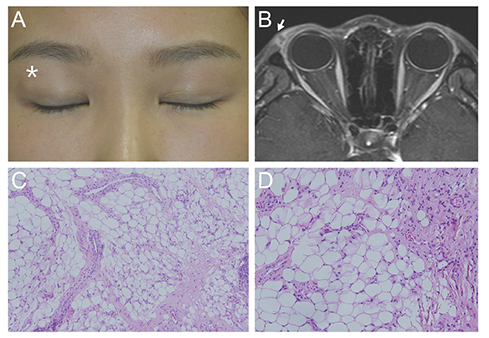Korean J Ophthalmol.
2016 Feb;30(1):10-16. 10.3341/kjo.2016.30.1.10.
Periorbital Lipogranuloma after Facial Autologous Fat Injection and Its Treatment Outcomes
- Affiliations
-
- 1Department of Ophthalmology, Seoul National University Bundang Hospital, Seoul National University College of Medicine, Seongnam, Korea. resourceful@hanmail.net
- KMID: 2363885
- DOI: http://doi.org/10.3341/kjo.2016.30.1.10
Abstract
- PURPOSE
To investigate periorbital lipogranuloma cases that developed after autologous fat injection and to determine various treatment outcomes from these cases.
METHODS
This retrospective study involved 27 patients who presented with periocular mass (final diagnosis of lipogranuloma) and had history of facial autologous fat injection. The collected data included information on patient sex, age, clinical presentation, number and site of fat injections, interval between injections, duration from injection to symptom onset, fat harvesting site, use of cryopreservation, and treatment outcome.
RESULTS
The most common presenting symptom was palpable mass (92.6%), followed by blepharoptosis and eyelid edema. The mean time from injection to symptom onset was 13.6 +/- 29.2 months (range, 2 to 153 months). Patients were managed by intralesional triamcinolone injection (six patients) and surgical excision (three patients); 18 patients were followed without treatment. Among the six patients who underwent intralesional triamcinolone injection, five showed complete resolution, and one showed partial resolution. Among the 18 patients who were followed without management, three showed spontaneous resolution over a 5-month follow-up period.
CONCLUSIONS
Lipogranuloma can develop in the eyelid after autologous fat injection into the face. Both surgical excision and intralesional triamcinolone injection yield relatively good outcomes. Simple observation can be a good option because spontaneous resolution can occur in a subset of patients.
MeSH Terms
-
Adipose Tissue/*transplantation
Adult
Autografts
Cosmetic Techniques/*adverse effects
Eyelid Diseases/diagnostic imaging/*etiology/therapy
Female
Granuloma, Foreign-Body/diagnostic imaging/*etiology/therapy
Humans
Injections
Magnetic Resonance Imaging
Male
Middle Aged
Orbital Diseases/diagnostic imaging/*etiology/therapy
Retrospective Studies
Rhytidoplasty/*adverse effects
Young Adult
Figure
Reference
-
1. Coleman SR. Facial recontouring with lipostructure. Clin Plast Surg. 1997; 24:347–367.2. Locke MB, de Chalain TM. Current practice in autologous fat transplantation: suggested clinical guidelines based on a review of recent literature. Ann Plast Surg. 2008; 60:98–102.3. Hong JW, Kim SM. An analysis of the experiences of 62 patients with moderate complications after full-face fat injection for augmentation. Plast Reconstr Surg. 2013; 131:918e–920e.4. Paik JS, Cho WK, Park GS, Yang SW. Eyelid-associated complications after autogenous fat injection for cosmetic forehead augmentation. BMC Ophthalmol. 2013; 13:32.5. Ryeung Park Y, Choi JA, Yoon La T. Periorbital lipogranuloma after cryopreserved autologous fat injection at forehead: unexpected complication of a popular cosmetic procedure. Can J Ophthalmol. 2013; 48:e166–e168.6. Lemperle G, Morhenn V, Charrier U. Human histology and persistence of various injectable filler substances for soft tissue augmentation. Aesthetic Plast Surg. 2003; 27:354–366.7. Son D, Oh J, Choi T, et al. Viability of fat cells over time after syringe suction lipectomy: the effects of cryopreservation. Ann Plast Surg. 2010; 65:354–360.8. Sa HS, Woo KI, Suh YL, Kim YD. Periorbital lipogranuloma: a previously unknown complication of autologous fat injections for facial augmentation. Br J Ophthalmol. 2011; 95:1259–1263.
- Full Text Links
- Actions
-
Cited
- CITED
-
- Close
- Share
- Similar articles
-
- Periorbital Lipogranuloma after Autologous Fat Injection for Facial Augmentation
- Periorbital Lipogranuloma after Autologous Fat Injection for Forehead Augmentation
- Autologous fat injection and collagen impantation for the correction of facial atroply
- Clinical evaluation of autologous fat graft for facial deformity: a case series study
- Comparisons between fresh and cryopreserved fat injections in facial lipofilling



